

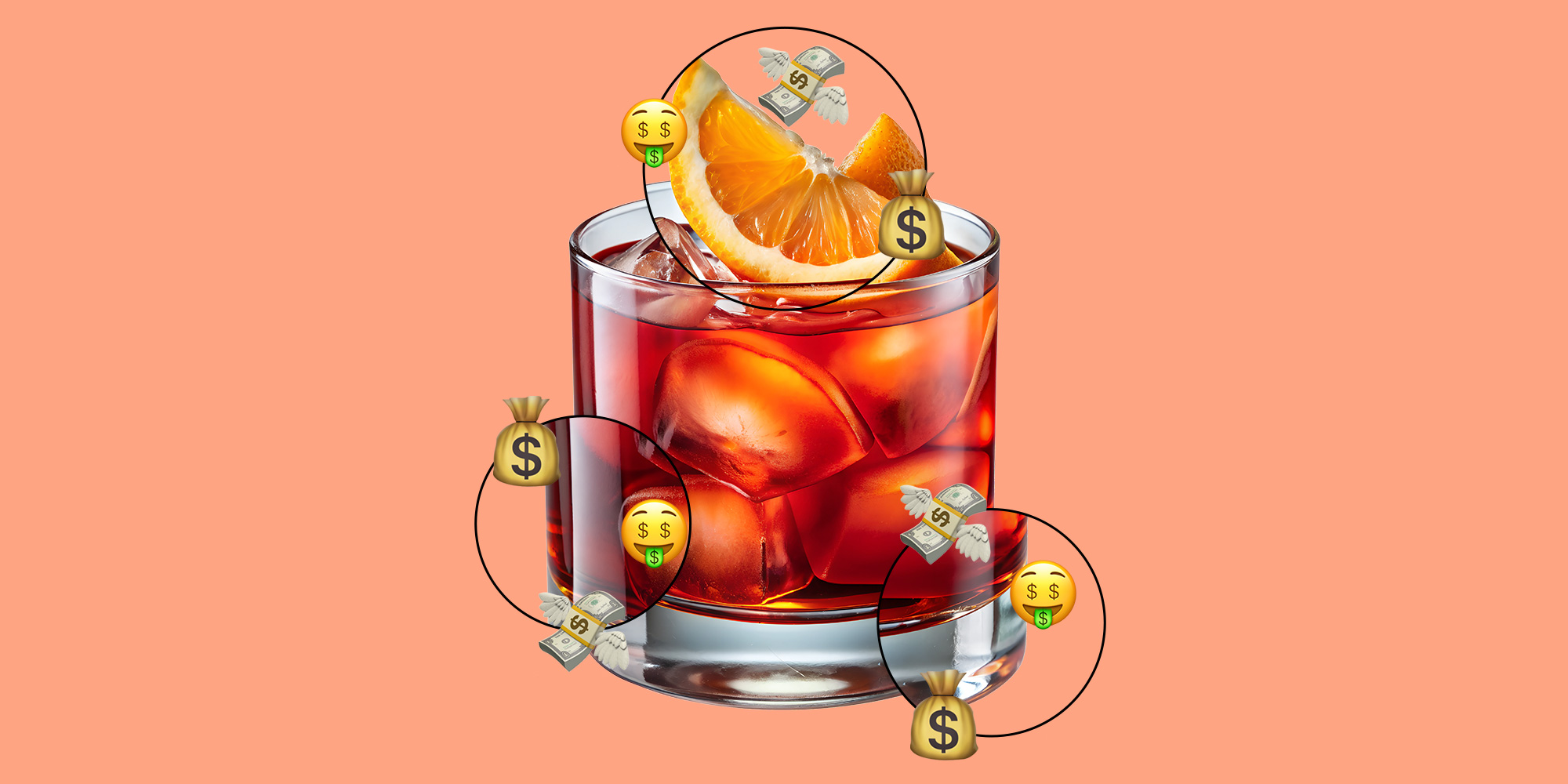
Few drinks carry the cachet of a Negroni. The stirred, bitter cocktail is ubiquitous enough to boast its own eponymous week in the industry and is considered to be the most popular cocktail in the world. It also possesses a level of social media clout that passing drink fads cannot touch: It turned Stanley Tucci into a temporary pariah after he pulled a James Bond and shook the drink on Instagram, and the Negroni Sbagliato (with Prosecco in it!) took bars by storm in late 2022. It’s also the occasional subject of more tone-deaf discussions; type “Is a Negroni” into Google, and “a girly drink” and “a man’s drink” both populate the search bar. (The correct answer: It’s a drink for everyone).
The Negroni is also a simple cocktail, built from a classic 1-1-1 ratio of gin, Campari, and sweet vermouth. Its foundation makes it ripe for riffs, but its base specs of pure alcohol with no fruit juice or fancy accouterments makes it a no-muss, no-fuss cocktail that’s quick to make — and sometimes, just as quick to enjoy. This simplicity tends to make a Negroni a cost-effective drink on-premise, but it also makes it a little tricky for bar owners and managers to price. If it’s too low, it could cut into their already slight margins. If it’s too high, it could cause customers to raise an eyebrow, suspecting that they’re getting ripped off. So, how do the professionals find the sweet spot?
The answer can vary. Here, five bars from five different cities across the country break down exactly how they price a standard Negroni.
Ingredients: $3.32
Labor: $1.34
Glassware: $4.12
Ice: $0.70
Operating Expenses: $2.25
Total Cost: $11.73
Profit: $7.27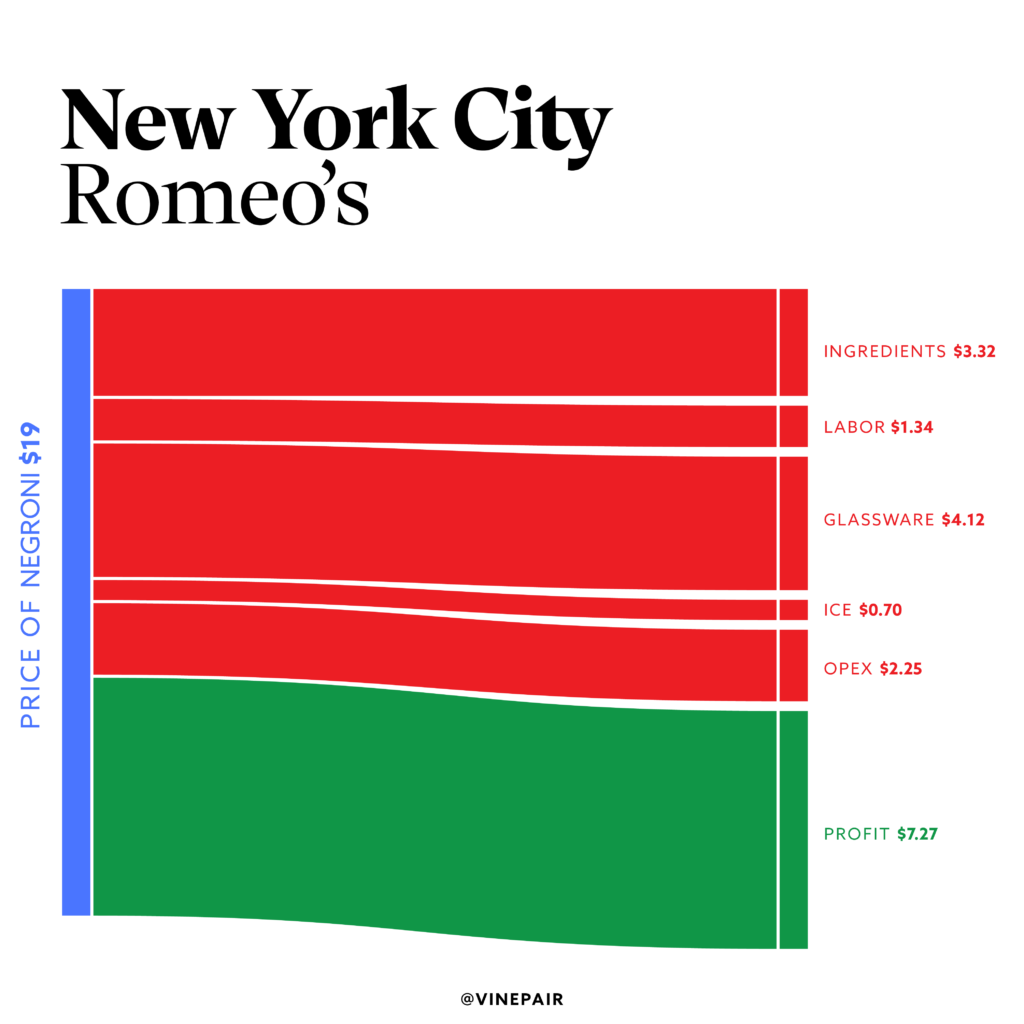
It’s no secret that New York is home to high-priced cocktails. This can induce sticker shock for the unprepared out-of-towner, but locals roll with it as a fact of Big Apple life. Still, some bars fight tooth-and-nail to keep cocktail prices as low as possible without disrupting business costs and a chance at profitability. This ‘90s-inspired cocktail bar in the East Village keeps its Negroni at $19, in line with its goal of not crossing the $20 threshold on the menu.
“We’re trying to hold back the barbarians at the gate by keeping our highest-priced drink at $19 as long as we can,” explains Romeo’s owner, Evan Hawkins. “I love some of those bars in the city that charge a lot for drinks, and I love the people behind those bars. But it’s not for me.”
Hawkins acknowledges his prices have nudged upward since he opened, and that his Negroni’s price tag is a product of doing business in New York City. He cites usual contributing factors like labor and rent costs, but he also points to sneakier price drivers like exceptional ice and high-quality, sturdy glassware that fit the bar’s aesthetic. The locals haven’t raised a stink or started questioning the price hikes yet, nor does he think they will.
“Most of the time, the increases have gone extremely unnoticed,” he says. “I think it’s because they’re having too good a time to care.”
Ingredients: $2.66
Labor: $2.13
Rent and Utilities: $2.85
Taxes: $3.43
Credit Card Fees: $0.49
Insurance: $0.35
Total Cost: $11.91
Profit: $2.09
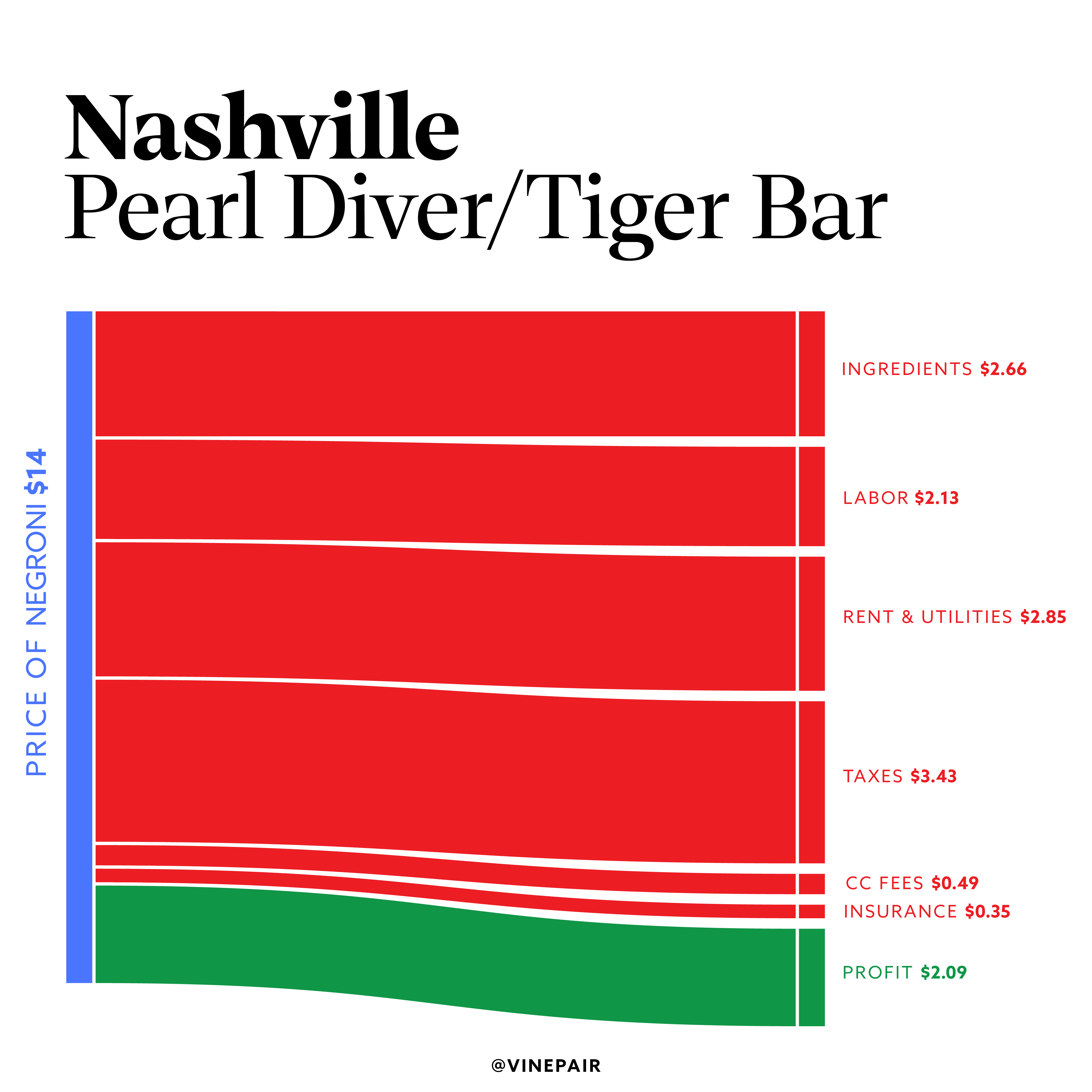
Determining the cost of a cocktail at multiple sister establishments can be a challenge; the owner may be the same, but the financial responsibilities may not be equal bar to bar. Such is the case with East Nashville’s Pearl Diver and Tiger Bar. According to the cocktail bars’ co-owner Jamie White, Tiger Bar’s rent is three times that of Pearl Diver, even though they’re roughly one mile down the road from each other. White tracks the Negroni’s cost of the two places aggregately, which simplifies things. Another major factor in pricing White’s drinks is a Tennessee-specific issue.
“The state of Tennessee has the highest by-the-drink tax in the U.S. at 24.55 percent,” he explains. “Just imagine — one week of profit on a month’s worth of drinks goes right back to the state.”
Despite these hurdles, White keeps his Negroni priced the same at both places: $14. Because his bars are in a quirky neighborhood populated by city creatives and are removed from downtown Nashville’s honky-tonk bustle, he makes it a point to stick to a number that’s low for the local clientele. Doing so requires constant analysis of factors that may cause price bumps, from getting weekly distribution price checks from brand representatives to following key industry news like shipping strikes. Guests do appreciate the diligence for the most part, though White notes that he does get a few grumbles when rising costs force him to raise his menu prices along with them.
“We don’t get a lot of complaints, but there are always a handful,” he says. “We try to keep our prices pretty fair. If anyone has an issue with it, they can always go downtown and get the same drink for $8 more.”
Ingredients: $2.75
Rent: $0.72
Labor: $1.14
Insurance: $0.16
Glassware: $0.03
Ice: $0.08
Operating Expenses: $0.30
Total Cost: $5.18
Profit: $9.82
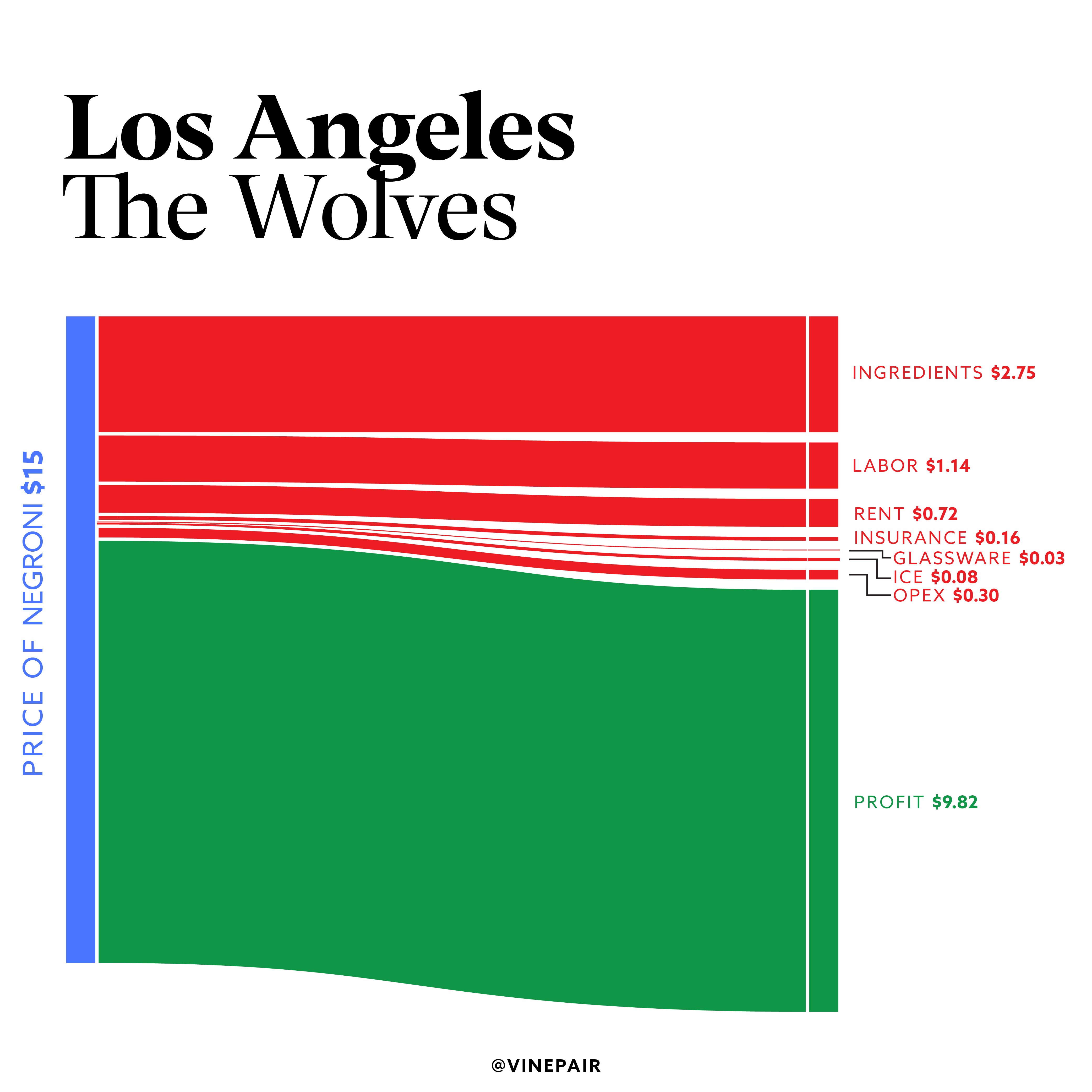
The price of a cocktail — or any type of good or service, for the most part — is partially dictated by its city or region. This correlation isn’t just due to rent or pricier ingredients; sometimes, the city the bar calls home puts up more hurdles to clear when it comes to hospitality. This is a point of concern for The Wolves, located in downtown Los Angeles’s historic core. According to general manager and bar director Nathan McCullough, the bevy of taxes and fees the city levies on small businesses makes it challenging to keep their cost of a basic Negroni at $15.
“We try to keep our prices fair, but L.A. seems to keep coming up with different ways to charge small businesses, whether it’s new operating charges or raising existing costs like doubling the price of insurance,” McCullough says. “We try to keep prices fair, but I just wish that the city could help make this easier. It’s strange, you would think that it would be in their best interest to help bars and restaurants thrive.”
Fortunately, McCullough says that his regulars empathize, and any reluctant price increases are tolerable in the eyes of most patrons. That said, McCollough and his staff are prepared for those who take umbrage.
“We haven’t had a lot of backlash for any of our price increases, but we get complaints every so often,” he says. “When they ask why, we’re very up front about any adjustments we make. Hopefully, they become appreciative that we sometimes have to make adjustments to survive.”
Ingredients: $2.52
Labor: $4.20
Rent: $0.98
Taxes: $0.84
Utilities and Maintenance: $0.77
Operating Expenses: $0.98
Credit Card Fees: $0.49
Security: $0.28
Miscellaneous: $1.40
Total Cost: $12.46
Profit: $1.54
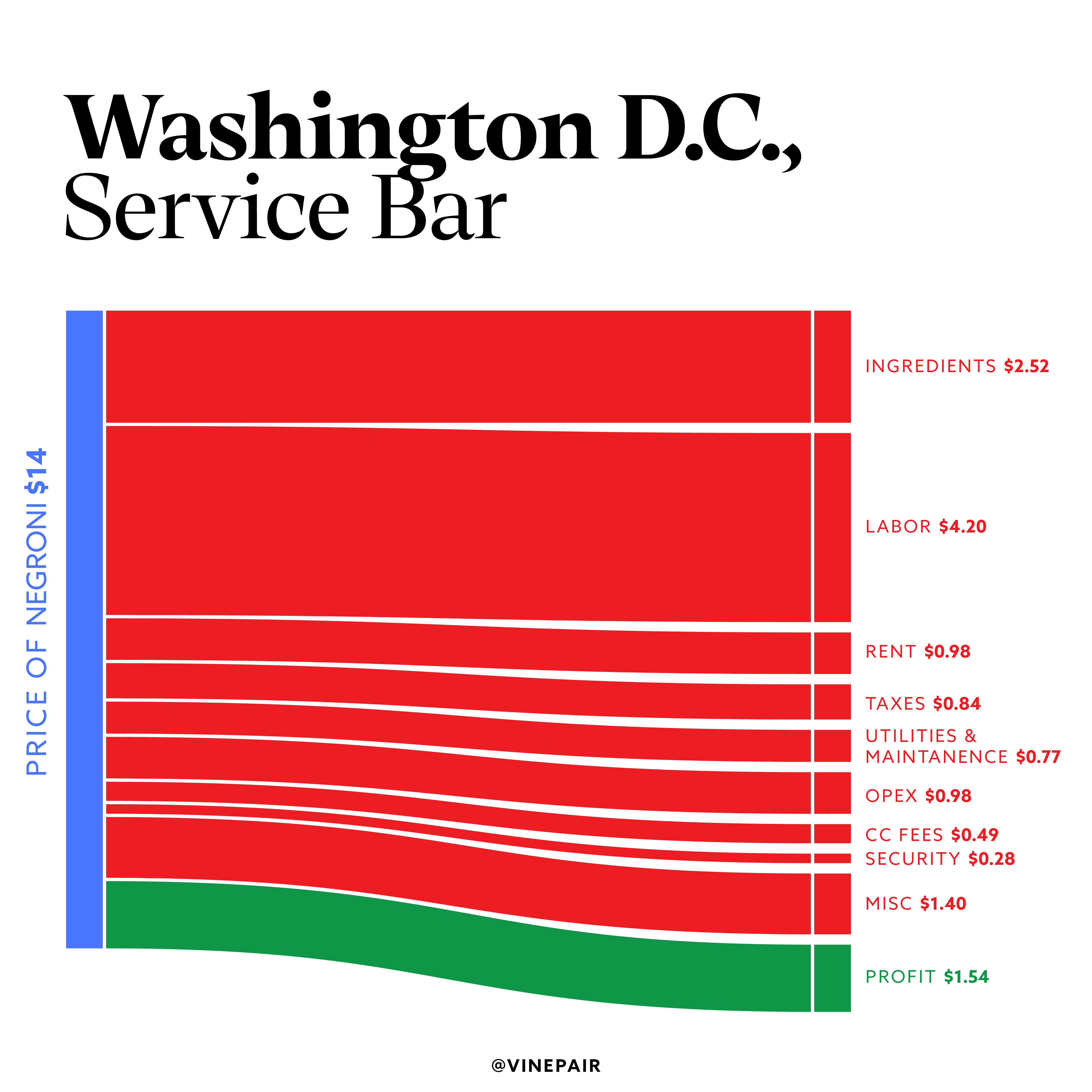
Like the Negroni itself, creating a bar menu that turns a profit requires balance. At Washington, D.C.’s acclaimed Service Bar, the $14 Negroni reflects the bar’s ethos of being a neighborhood bar first and a cocktail bar second. But it also reflects the effort to attain balance between profitability and fairness for the consumer and the bartenders themselves.
“If you are looking at gross margin, bars typically are going to try and keep an overall cost of goods sold [COGS] of less than 25 percent,” explains Service Bar co-owner Chad Spangler. “One of the reasons costs are going up is that you typically look at keeping a prime cost — which is COGS plus labor — under 55 percent, and labor is going up a lot. Part of keeping this balance is lowering the COGS target to accommodate for a higher labor cost.”
Spangler notes other costs like occupancy, utilities, operating costs, and credit card payment systems drop the drink’s profit margin to around 15 percent. Unexpected miscellaneous expenses can reduce the margins even further. Whether this matters on the other side of the stick depends on the customer’s attitude.
“I think it is worth stopping to consider how much it would cost you to hire someone to come to your home and prepare, serve, and clean up after,” says Spangler. “Then, you realize how nicely priced bars really are.”
Ingredients: $2.06
Labor: $2.82
Rent: $0.18
Insurance: $0.04
Utilities: $0.03
Credit Card Fees: $0.39
Miscellaneous: $0.22
Total Cost: $5.74
Profit: $7.26
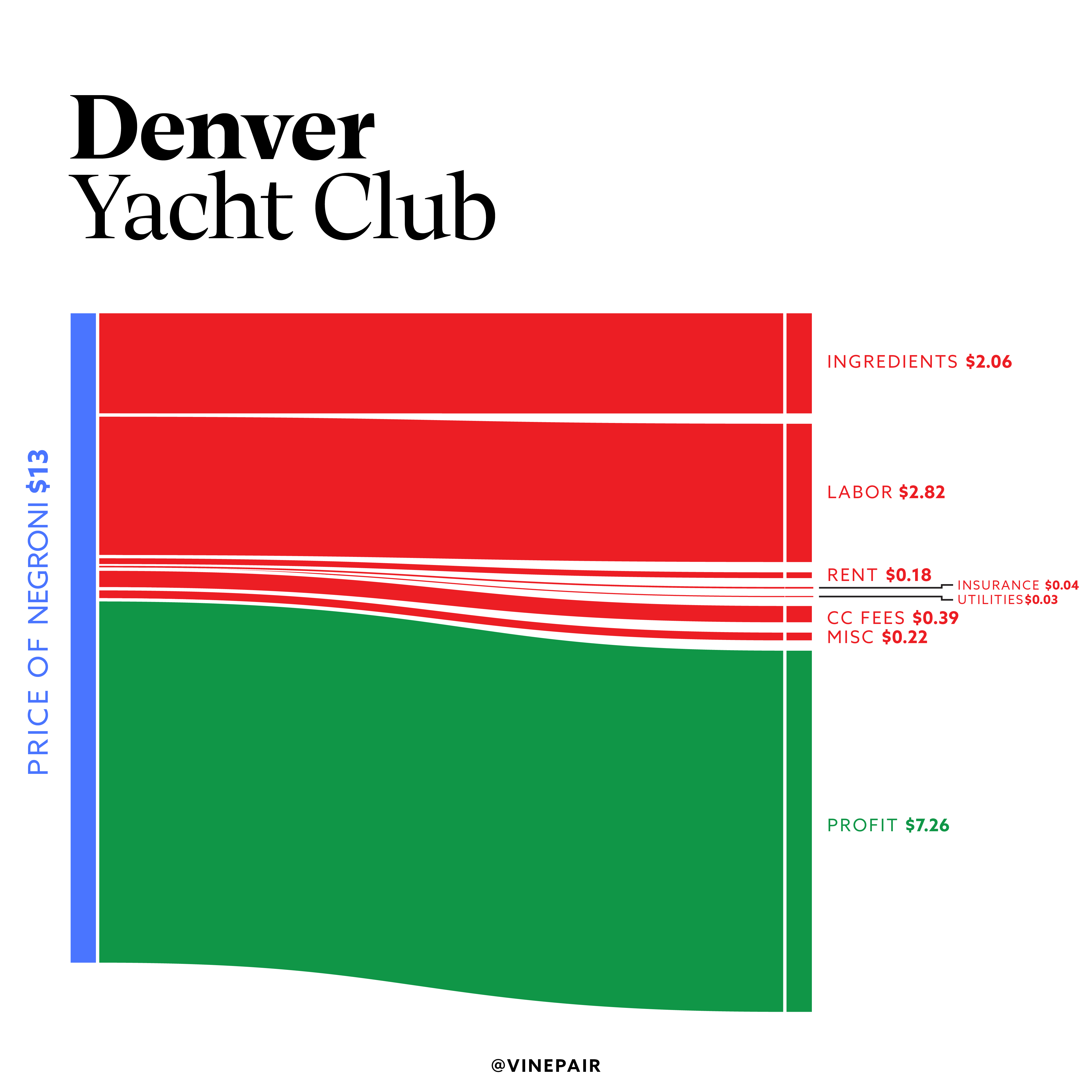
This award-winning “anti-club club” in Denver’s old-school Cole neighborhood breaks down the Negroni’s cost by the minute for optimized economic accuracy. Co-owner McLain Hedges also knows that there’s more to the drink’s value than strict dollars and cents. It doesn’t take long to whip one up for a guest, and this affords the staff more time to build trust with guests, rapport with regulars, and a better overall customer experience.
“A Negroni is classic, foundational, easy to make, and delicious,” explains co-owner McLain Hedges. “It’s a drink that allows us to do all the other stuff that brings people joy.”
This back-and-forth with guests can also lead to more in-depth chatter about the preferred Negroni’s build: Neat or a rock? Well gin or premium gin? What type of vermouth? The answers can lead to tweaks that can raise the price above the menu’s standard $13. The Negroni still produces a profit due to the bar’s low overhead, and while the bar could make more on the drink, Hedges notes that the low price tag gives him a little more wiggle room to offer guests unique treats.
“A Negroni’s cost is super controllable. Even with inflation, we know the prices of the ingredients aren’t going to double in price overnight,” Hedges says. “This allows us to find places on the menu where we can make up costs elsewhere, like a rare spirit or a unique bottle of wine. At the end of the day, this control makes it easier for us to justify more opportunities to give our guests access to things that can blow their mind.”
The article The Economics of a Negroni at 5 Top Bars, Visualized appeared first on VinePair.